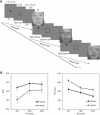Dynamic Trial-by-Trial Recoding of Task-Set Representations in the Frontoparietal Cortex Mediates Behavioral Flexibility
- PMID: 28972126
- PMCID: PMC5678027
- DOI: 10.1523/JNEUROSCI.0935-17.2017
Dynamic Trial-by-Trial Recoding of Task-Set Representations in the Frontoparietal Cortex Mediates Behavioral Flexibility
Abstract
Cognitive flexibility forms the core of the extraordinary ability of humans to adapt, but the precise neural mechanisms underlying our ability to nimbly shift between task sets remain poorly understood. Recent functional magnetic resonance imaging (fMRI) studies employing multivoxel pattern analysis (MVPA) have shown that a currently relevant task set can be decoded from activity patterns in the frontoparietal cortex, but whether these regions support the dynamic transformation of task sets from trial to trial is not clear. Here, we combined a cued task-switching protocol with human (both sexes) fMRI, and harnessed representational similarity analysis (RSA) to facilitate a novel assessment of trial-by-trial changes in neural task-set representations. We first used MVPA to define task-sensitive frontoparietal and visual regions and found that neural task-set representations on switch trials are less stably encoded than on repeat trials. We then exploited RSA to show that the neural representational pattern dissimilarity across consecutive trials is greater for switch trials than for repeat trials, and that the degree of this pattern dissimilarity predicts behavior. Moreover, the overall neural pattern of representational dissimilarities followed from the assumption that repeating sets, compared with switching sets, results in stronger neural task representations. Finally, when moving from cue to target phase within a trial, pattern dissimilarities tracked the transformation from previous-trial task representations to the currently relevant set. These results provide neural evidence for the longstanding assumptions of an effortful task-set reconfiguration process hampered by task-set inertia, and they demonstrate that frontoparietal and stimulus processing regions support "dynamic adaptive coding," flexibly representing changing task sets in a trial-by-trial fashion.SIGNIFICANCE STATEMENT Humans can fluently switch between different tasks, reflecting an ability to dynamically configure "task sets," rule representations that link stimuli to appropriate responses. Recent studies show that neural signals in frontal and parietal brain regions can tell us which of two tasks a person is currently performing. However, it is not known whether these regions are also involved in dynamically reconfiguring task-set representations when switching between tasks. Here we measured human brain activity during task switching and tracked the similarity of neural task-set representations from trial to trial. We show that frontal and parietal brain regions flexibly recode changing task sets in a trial-by-trial fashion, and that task-set similarity over consecutive trials predicts behavior.
Keywords: cognitive control; cognitive flexibility; fMRI; frontoparietal cortex; representational similarity analysis; task switching.
Copyright © 2017 the authors 0270-6474/17/3711037-14$15.00/0.
Figures






Similar articles
-
Switch-Independent Task Representations in Frontal and Parietal Cortex.J Neurosci. 2017 Aug 16;37(33):8033-8042. doi: 10.1523/JNEUROSCI.3656-16.2017. Epub 2017 Jul 20. J Neurosci. 2017. PMID: 28729441 Free PMC article.
-
Representational Organization of Novel Task Sets during Proactive Encoding.J Neurosci. 2019 Oct 16;39(42):8386-8397. doi: 10.1523/JNEUROSCI.0725-19.2019. Epub 2019 Aug 19. J Neurosci. 2019. PMID: 31427394 Free PMC article.
-
A neural mechanism of cognitive control for resolving conflict between abstract task rules.Cortex. 2016 Dec;85:13-24. doi: 10.1016/j.cortex.2016.09.018. Epub 2016 Oct 1. Cortex. 2016. PMID: 27771559 Free PMC article.
-
The cross-functional role of frontoparietal regions in cognition: internal attention as the overarching mechanism.Prog Neurobiol. 2014 May;116:66-86. doi: 10.1016/j.pneurobio.2014.02.002. Epub 2014 Feb 12. Prog Neurobiol. 2014. PMID: 24530293 Review.
-
Task set and prefrontal cortex.Annu Rev Neurosci. 2008;31:219-45. doi: 10.1146/annurev.neuro.31.060407.125642. Annu Rev Neurosci. 2008. PMID: 18558854 Review.
Cited by
-
Integrated externally and internally generated task predictions jointly guide cognitive control in prefrontal cortex.Elife. 2018 Aug 16;7:e39497. doi: 10.7554/eLife.39497. Elife. 2018. PMID: 30113310 Free PMC article.
-
Bottom-Up and Top-Down Factors Differentially Influence Stimulus Representations Across Large-Scale Attentional Networks.J Neurosci. 2018 Mar 7;38(10):2495-2504. doi: 10.1523/JNEUROSCI.2724-17.2018. Epub 2018 Feb 2. J Neurosci. 2018. PMID: 29437930 Free PMC article.
-
Reward Boosts Neural Coding of Task Rules to Optimize Cognitive Flexibility.J Neurosci. 2019 Oct 23;39(43):8549-8561. doi: 10.1523/JNEUROSCI.0631-19.2019. Epub 2019 Sep 13. J Neurosci. 2019. PMID: 31519820 Free PMC article.
-
Attention switching through text dissimilarity: a cognition research on fragmented reading behavior.Front Hum Neurosci. 2024 Jun 25;18:1402746. doi: 10.3389/fnhum.2024.1402746. eCollection 2024. Front Hum Neurosci. 2024. PMID: 38983754 Free PMC article.
-
Neural Dynamics of Context-sensitive Adjustments in Cognitive Flexibility.J Cogn Neurosci. 2022 Feb 1;34(3):480-494. doi: 10.1162/jocn_a_01813. J Cogn Neurosci. 2022. PMID: 35015871 Free PMC article.
References
-
- Allport DA, Styles EA, Hsieh S (1994) Shifting intentional set: exploring the dynamic control of tasks. Attention Perform 15:421–452.
-
- Benjamini Y, Hochberg Y (1995) Controlling the false discovery rate: a practical and powerful approach to multiple testing. J R Statist Soc B (Methodological) 57:289–300.
-
- Benjamini Y, Yekutieli D (2001) The control of the false discovery rate in multiple testing under dependency. Ann Stat 29:1165–1188. 10.1214/aos/1013699998 - DOI
MeSH terms
Grants and funding
LinkOut - more resources
Full Text Sources
Other Literature Sources
